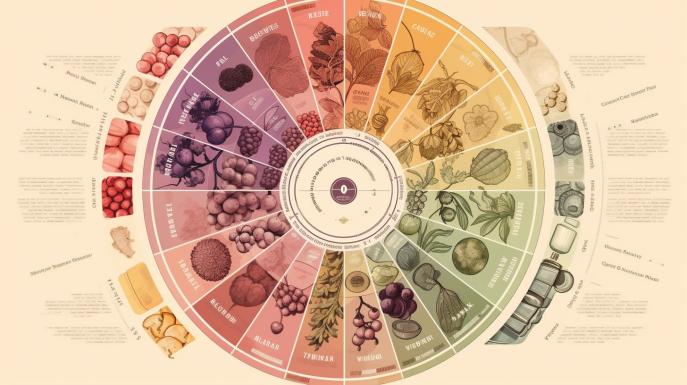Imagine the taste of a meal elevated to new heights, where each bite is an act of discovery, each sip a meeting of kindred spirits in liquid and solid form. “Wine Pairing Guide: Simple Tips” is not just a read; it is a journey through the essence of balanced flavors and memorable gastronomic encounters. Discover how pairing wine and food can transform your table into a stage for sensory experiences, and why even beginners should embrace this art. Let this guide be the key to unlocking the perfect pair that awaits your plate.
Why is wine and food pairing so important to the dining experience?
Pairing wine and food significantly elevates the culinary experience. Through the correct combination, flavors are enhanced, transforming a simple dinner into a moment of celebration for the palate. Even for beginners, understanding the basics of marriage is crucial to enjoying each meal to the fullest. By evaluating the weight and intensity of the chosen dishes and wines, it is ensured that one does not overpower the other. Light white wines pair well with more subtle dishes, while robust red wines are ideal for fuller-bodied meals.
What are the basic principles for pairing different types of wines and dishes?
To balance the intensity and weight between wine and food, the body of the wine and the structure of the dish are considered. Delicate dishes require light wines, while robust dishes pair well with full-bodied wines. Choosing wine for specific dishes demands attention to the characteristics of the wine, such as acidity, sweetness, tannins and flavors. For example, dishes with greater acidity go well with wines that share this trait. Regionality is also a factor; There is a popular saying that says “what grows together, goes together”, reflecting how dishes and wines from the same region often complement each other. For more sommelier advice on pairing, click here.
How to select the ideal wine for each food category?
For red meat, choose a robust red wine, such as Cabernet Sauvignon. White wine, such as Chardonnay, pairs well with seafood. Cheeses and desserts call for wines with sweet notes, such as Port or Sauternes. When selecting the ideal wine, consider the intensity and weight of the wine in relation to the dish.
What practical tips help promote successful wine and food pairings?
Wine temperature is crucial when pairing because it enhances or attenuates flavors. White wines should be served cold, and red wines should be served a little below room temperature. The choice of glass is also fundamental, as it can intensify aromas and flavors; Larger, more open glasses are better for robust red wines, while white wines benefit from smaller glasses, which concentrate the aromas. To expand your knowledge and experience, participate in wine tasting events; These are excellent opportunities to explore and better understand the subtleties of harmonization.
As we delve into the art of wine and food pairing, we recognize its ability to elevate cuisine to new heights. The nuances of flavor coming together in a delicate ballet on the palate reveal why even beginners benefit from understanding the basic principles of this pairing. The gastronomic experience becomes something memorable when wine and dish are in harmony, respecting intensity and regionality, whether in an intimate dinner or a large celebration. When selecting the ideal wine for each food, from red meat to the most delicate desserts, connoisseurs are guided by a compass of flavors and aromas. And, in practical tips, we realize that details such as temperature and choosing the correct glass are gestures of affection towards the drink that complement the act of eating. Finally, tasting events appear as a way to experience and expand our perceptions in this world of shared flavors.
FAQ
- Why is wine and food pairing essential in the gastronomic experience? The importance of pairing wine and food is due to the enhancement of flavors it provides, transforming an ordinary meal into a sensorial celebration. The appropriate combination of wines and dishes ensures that the flavors of both complement each other, elevating the culinary experience.
- What are the basic principles for pairing wines with food? The basic principles of pairing involve balancing the intensity and body of the wine and the dish. Light wines are recommended for delicate dishes, while robust dishes require full-bodied wines. Characteristics such as acidity, sweetness, tannins and flavors of the wine must be considered, as well as the idea that ingredients and wines from the same region tend to harmonize well.
- How can I select the ideal wine for different types of food? To select the ideal wine, you must consider the food category. Robust red wine is recommended for red meat, while seafood dishes pair well with white wines such as Chardonnay. For cheeses and desserts, opt for wines with sweet notes, such as Port or Sauternes.
- What are some practical tips for successful wine and food pairings? To promote successful pairing, the temperature of the wine must be considered, as it influences the flavor; White wines should be served cold, and red wines should be served slightly below room temperature. Choosing the correct glass is also essential, as the shape can enhance or mitigate the aromas and flavors of the wine, with larger glasses benefiting robust red wines and smaller glasses favoring white wines. Attending tasting events can expand your understanding and appreciation of the nuances in pairing.



